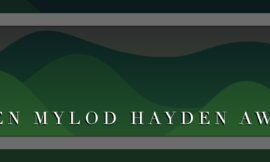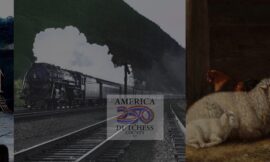Topics

Excellence in Education
Honors teachers at Dutchess County middle or high schools who bring innovation and creativity to impart a love and appreciation of local history. 2022 Awardee:Henry Frischknecht, Bulkeley Middle School, Rhinebeck Henry came to our attention last summer when he led an effort across Bulkeley Middle School Social Studies Classes, in Rhinebeck, encouraging students to creatively express what they learned about the event called Juneteenth, which had just been announced as a new federal holiday. Ensuring students were briefed with a good deal of local history, students created individual flags that when put together added up to a single iconic flag that was featured on the front lawn of Rhinebeck Town Hall. Frischknecht is known for having abandoned the old memorize-and-test approach. Instead, he invents creative approaches that use innovative technology to first inform students about a subject, and then subsequently asks them to express their critical thinking and understanding in equally creative ways. One of his most recent projects involves having students develop a documentary film discussing topics related to the Civil War. He has brought in local film makers, leveraged students’ technological aptitude and brought in a multitude of primary sources, allowing them to research, script, film, and edit their own movies. “This is the kind of authentic experience that helps our kids to think critically and be creative outside of the classroom” he said. Henry holds a BA in Liberal Arts from Dutchess Community College, continued his education at SUNY Albany where he majored in History with minors in Religious Studies and Anthropology, and completed his M.Ed degree at Marist in 2010.
Posted in: Awards, DHCS Events, For everyone
The Hudson River as Battlefield
THIS PAGE IS UNDER CONSTRUCTION TO AN UPDATED PLATFORM, THANK YOU FOR YOUR PATIENCE… This online exhibition offers insights into the October 1777 British action, as well as insights into Franklin Roosevelt’s unrelenting commitment to the understanding and publication of local history even as global war emerged and commenced. jump to FDR’s Yearbook Articles on the October 1777 event jump to British Ship Logs Obtained by FDR jump to June 1777 Livingston Letter: Me Worry? Won’t Happen! jump to What a Cannonball Can Do George Washington called West Point, just south of Dutchess County on the Hudson River, the key to the North American Continent. Historians agree the success of the American patriots relied on the defense of the Hudson River Valley, which the British where the British hoped to take control to divide the emerging United States in half. In October of 1777 a single trip north by the British as far as Red Hook, Dutchess County, did show the potential for such a raid, and resulted in the complete destruction of the capital of New York at the time, Kingston. Certain homes, barns with agricultural products, and stores were targeted with cannon ball or were torched and burned. The dramatic event would attract the attention of any local historian. But the fact that the ships traversed the area of Franklin Roosevelt’s ancestral homes, gave it an extra dimension and power for him. FDR’s Yearbook Articles President Roosevelt wrote an article for each of the 1935 and 1936 DCHS Yearbooks, where his trusted partner, Helen Wilkinson Reynolds was editor. DCHS’s Helen Wilkinson Reynolds. back to top British Documents DCHS Collections: Envelope containing information from the British Admiralty directed to FDR, who then gave them to DCHS. The articles are written about the material he obtained through requests to the head of the British Admiralty and the US Embassy in London. Britain’s Lord Halifax shown at right. Middle top: with Nazi leader Herman Goering. Middle bottom: with British Prime Minister Winston Churchill. Right: with FDR. When Halifax was made US Ambassador in 1941, FDR broke with protocol and met Halifax in his private sloop. back to top Henry Livingston, Sr. Letter Poughkeepsie June 16, 1777 Loving Brother, Your negro just now delivered me the Bond and Tenant Books with your letter of the 7th instant and am sorry you are again attacked with the gout. Your being so long freed was in hopes it would have quitted you. Captain Phillip Cortland was here this morning and left Peeks Kill yesterday all in quietness and the Armies in Jersey as yet very peaceable. As for the English Army coming up this river I am under no apprehension of, because I think it would be great madness in attempting it. We are all in good health and join in our love to your sister and children. And am… your loving brother, Henry Livingston. back to top Henry Livingston, Jr. House The son of the author of the letter found his home hit by a single cannonball. The 1919 DCHS Yearbook published a photograph of the patched shingle at the front of the house (right). Among the artifacts in DCHS Collections is the beam that was damaged by the cannonball in 1777 (below). It was removed when the house was demolished in the late 19th century. back to top
Posted in: 18th Century, Countywide, For everyone
“They Suppose You Are a Gentleman:” Caroline Clowes’ Extraordinary Path to National Artistic Acclaim
Posted in: Women's History

Free Black Communities
Free Black Communities: Bulwarks of Safety Before the Civil War The January 26, 2022 edition of the No./So. Dutchess News / Beacon Free Press contains a version of this article. By Bill Jeffway For persons of color, the 66 years between New York State’s 1799 Gradual Emancipation Act (a promise of the abolition of slavery that was realized in 1827) and the 1865 national abolition of slavery, was a period of great peril. Five years into New York being a “Free State,” in 1832, a well-known Poughkeepsie stagecoach proprietor named Isaac Butler was heading to Virginia to sell horses. He asked a local Black man if he would allow the man’s young son to come along to help. The father said yes. Butler returned to Poughkeepsie, but not with the boy, saying the boy had run away. The young boy’s astute petitioning for justice in Virginia, naming prominent men in Poughkeepsie that he knew of, had the good fortune to be heard by someone who knew Poughkeepsie’s Judge James Emmo. The plot was exposed and reversed, and the boy returned to Poughkeepsie. The need for security was obvious. One of the ways Blacks sought greater security in this period was by coalescing in small, rural communities. This afforded the potential to own property, even if the land was poor, and allowed a proximity that improved communications and safety. Above: An 1845 Poughkeepsie directory (DCHS Collections) lists Isaac Butler. He was a high-profile, longstanding operator of a livery stable and a stage coach service between Poughkeepsie and Connecticut. His 1832 kidnapping of an enslaved Black boy was foiled with the intervention of Poughkeepsie’s Judge James Emott. Court records show that Butler was formally charged, but a ruling in the case has not been located. In 1850, just before his death, Isaac Butler was among the contributors to the fund that successfully bought the freedom of the fugitive slave John Bolding. Bolding had escaped enslavement and moved to Poughkeepsie in 1845, but was identified by someone and returned to the south in 1850. The Black historian A. J. Williams Meyers writes, “Free Africans with their landholdings in rural areas … carved out that ‘social space’ for themselves and family… They created caring, nurturing, and religious communities up and down the Hudson Valley…many of them were mixed communities of African, European, and Native American descent. Because they were caring communities, free of racial strife, interracial couples were attracted to them. In the Hudson Valley [there were] such communities [as] Freemanville and Baxtertown east and west, respectively, in southern Dutchess County… They were steadfast in weakening the molding of a materially dispossessed and dependent African by nurturing a materially affluent African.” In addition to Freemanville and Baxtertown mentioned by Dr. Williams-Meyers, we will also look at Lithgow, Hyde Park’s New Guinea, and the less traditional situation (more central to the village than rural or marginal), Rhinebeck’s Oak Street. Freemanville Freemanville, sometimes called Guinea, and was located in the Town of Beekman near the village of Poughquag, and was named for its free Black founder, Charles Freeman. The Mid-Hudson Antislavery History Project reports, “By 1818 Freeman [then known as “Cesar Freeman”] had purchased 3 acres of land for $312, and this became the nucleus for Freemanville.” An illustration in the 1877 General History of Dutchess County by Philip Smith shows what is meant to be a typical Freemanville house. The house is two stories, has a traditional roofline, clapboard siding, and a high stone foundation suggesting it may have been built into the side of a wall. A sarcastic reference to a Freemanville “palace” from Philip Smith’s 1877 General History of Dutchess County. Often huts or crude houses are described as being built into the side of a hill, which may be indicated here. Despite the apparent personal testimony of Frank Hasbrouck that Henry or Harry Catskill was an Indigenous Person in appearance, the 1870 and 1880 Federal Census indicates he is Black (B). The only other option for race or color was the equally broadly interpreted Mulatto (M). Baxtertown About two miles northwest of the Village of Fishkill you will find Baxtertown Road. You will also find a 2015 historic roadside marker from the Pomeroy Foundation reading, “Site of Zion Pilgrim M.E. Church, Served Baxtertown Community 1848 to 1930s. Evidence suggests [it was a] station on [the] underground railroad.” Beyond this, nothing visible remains of the Baxtertown community. The lawyer and noted local historian Frank Hasbrouck wrote in 1909 that Baxtertown was a hamlet where Blacks, Indigenous Peoples, and multi-racial persons through their intermarriage made up a vibrant community. Like most of these free communities, the land was poor; it was rocky and swampy. Appearing to speak from direct, personal knowledge, and making the point that Native Peoples made up a good part of the hamlet, he describes one resident, Harry Catskill, as entirely Native in appearance, “a well-built, handsome man, with straight hair.” There are newspaper references to Baxtertown as a hamlet into the early 1900s. Baxtertown appears to be named for William Baxter (1805-1875), a White medical doctor who lived in the area. Lithgow In his 1958 book, Blithe Dutchess, Henry Noble MacCracken writes that “Lithgow, near Amenia, became the home of freed Negroes, who found employment on the farms in the area. Others drifted in as seasonal laborers. The Central Baptist Church of Clinton welcomed them.” We have not been able to find the kind of evidence we have found for other communities in census records and maps, but this is likely a factor of the impoverished, transient and seasonal nature of the population. More evidence is likely to be found with further research. New Guinea The New Guinea Community, one to two miles east of the center of the village of Hyde Park, will be the subject of a DCHS program on February 9th at 7 pm via Zoom (see end of article). Census records suggest that the population of persons of color peaked across two specific decades when it grew from around 50 enslaved persons in 1820, to perhaps 100 free persons
Posted in: African Heritage

